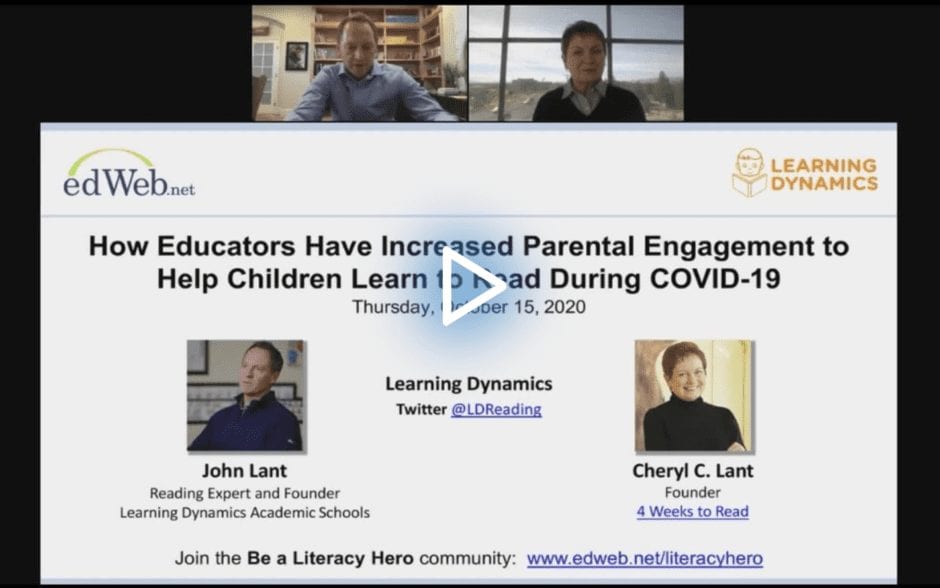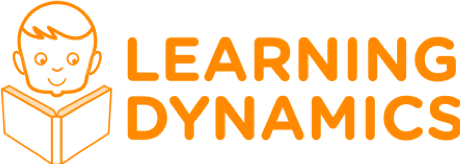Learning and Loving to Read Systematically
By Michele Israel
WATCH THE EDLEADER PANEL RECORDING
If young students say the letter R makes a /rih/ sound and M makes the /muh/ sound, there is a strong chance they might have trouble learning to read. While they studied the letters A to Z and their sounds, they probably cannot link them to actual words.
The learners are likely missing the blending and decoding skills that lead to reading fluency, explained John Lant, CEO, and Cheryl Lant, Founder, 4 Weeks to Read, in a recent edWeb edLeader Panel sponsored by 4 Weeks to Read. The Panel described the Lants’ research-based reading strategy that has strengthened the reading skills of over a half million children, ages three to six.
Teaching Reading with Students in Mind
It wasn’t a publishing company that the Lants set out to establish; schools are their thing. About 35 years ago, they launched Learning Dynamics Pre-School and currently manage six sites in Utah and Arizona. This is what sparked their interest in better supporting beginning readers.
Then they read the National Assessment of Educational Progress’ reading statistics. The numbers shocked the Lants: 70% of fourth-grade students cannot read at grade level; 30% of high school students are “below basic” in reading.
With their students’ achievement top-of-mind, the Lants wanted to identify the cause of the reading gap. They gathered materials from myriad publishers to discover that those developing them had little to no classroom experience.
“As we worked with kids in the classroom,” explained John, “we knew that the way to teach kids to read was to develop a product and reading materials that were based on how kids think, not on how adults think they should learn, but how they actually learn.”
It took the Lants 17 years of research—and trial and error—to design the simple but scientifically sound 4 Weeks to Read program for children.
The Approach
Six phonics-focused methodologies, determined by the defunct NICHD National Reading Panel as essential to foundational to literacy development, shape the program:
Phonics – Letters make sounds, but the range of sounds depends on the vowels that follow (so /rih/ for R and /muh/ for M do not make much stand-alone sound sense!).
Phonemics – This is the connection between a letter and the sound it makes. Readers should be able to identify and hear the sounds in words. “So, when learners look at the word “cat,” explained the Lants, “they hear the beginning, middle and ending sounds of /c/ /a/ /t/. That phonemic awareness is a huge part in teaching children to read.”
Blending and decoding – Readers make sense of words by blending and decoding concepts; when they see a word, they “hear” the sounds that, once put together, become a word. The Lants noted that these critical reading skills were absent from many of the programs they reviewed.
Fluency – Practice is what drives fluency; reading many beginning-level books and materials makes for better readers.
Vocabulary – When children read materials that relate to their lives, their vocabulary grows. Books with words that are already part of learners’ oral language launch fluency.
Comprehension – This is where readers should land, understanding words. It’s at this point when children read to learn.
The Construct
The Lants’ research pointed to the need for a systematic reading approach. 4 Weeks to Reading offers such a process.
Students learn one letter (not alphabetically) and one sound per lesson, starting with the most common letters M, A, P, S and T during the first five program weeks. Lessons are short 15-minute blocks delivered three days a week. Lesson brevity is a mainstay of the program’s success: Faster means learners will not remember letters and sounds.
Four weeks after the program’s start, learners dive into their first book, with one word per page comprised of eight letters and sounds learned to this point. As the lessons progress, they continue to blend with all of the letters they have learned earlier. The books build on each other, becoming harder as the program progresses. But readers’ decoding skills allow them to sound out more complex words.
The 53-book 4 Weeks to Read series (translated into Spanish)—with accompanying lesson manual, activity sheets, workbooks, music CDs (there are songs to strengthen letter comprehension), flashcards, pop-out letter rewards, and videos for distance learning—accommodates children’s unique reading skills and readiness. Learners progress at their pace and become more excited about reading and learning from book to book.
The Impact
The Lants said the program has achieved what they envisioned: getting children to read appropriate materials that intrinsically motivate them to continue reading.
“That’s where we want to get kids to…where they want to learn, study more and get to the next level,” the Lants emphasized. “We saw that as kids got into a reading book, they wanted to get to the next reading book. They couldn’t wait! They read the first one and ‘get it.’ And then they would learn a few more letters and dive into the second book.”
The program has been beneficial during the COVID-19 pandemic. A partnership with the Texas Education Agency enabled the Lants to bolster the state’s virtual learning program by providing 4 Weeks to Read materials to all underserved students’ homes across Texas, allowing teachers to help students develop reading skills at a distance.
The additional benefit of the Texas Education Agency relationship is increased parental engagement. The already parent-friendly program has an easy-to-follow manual that invites parents to support their children’s virtual learning experiences further. The integration between the classroom and the home has further boosted children’s reading competency.
This edWeb broadcast was sponsored by 4 Weeks to Read.
WATCH THE EDLEADER PANEL RECORDING
About the Presenters
John Lant is the founder of Learning Dynamics Academics Schools. Founded in 1984, Learning Dynamics is best known for its university validated reading program. With more than 30 years of experience, Learning Dynamics has six schools in Utah and Arizona and over 500,000 students have successfully completed the reading program. John attended Brigham Young University and graduated with a Master of Business Administration.
Cheryl C. Lant started Learning Dynamics Preschools in 1984. She developed 4 Weeks to Read in the school, working with teachers and the children. Today hundreds of thousands of children are learning to read using this program. She was also the president of a worldwide organization for children for 5 years.
Join the Community
Be a Literacy Hero is a free professional learning community on edWeb.net dedicated to helping educators activate every student’s greatest superpower: the power of literacy.
4 Weeks to Read by Learning Dynamics is the premiere reading program for children ages 4-8. This easy-to-use, phonics-based program was developed over 17 years of classroom application. It’s the only program where children earn and keep their own library of books throughout the program. Learning Dynamics is backed by research from the University of Oregon with a 98% success rate getting children to read at or above grade level.
Michele Israel writes about the ideas and best practices that are shared in edWeb’s edWebinars so they can spread innovative and best practices to the education community. Michele owns Michele Israel Consulting, LLC , which serves large and small educational, non-profit, media, corporate, eLearning, and blended learning organizations to bolster products and programs. Her rich career spans over 25 years of successfully developing educational materials and resources, designing and facilitating training, generating communication materials and grant proposals, and assisting in organizational and program development. In addition to lesson plans and other teacher resources, Michele’s portfolio includes published articles covering a range of educational and business topics.





Comments are closed.